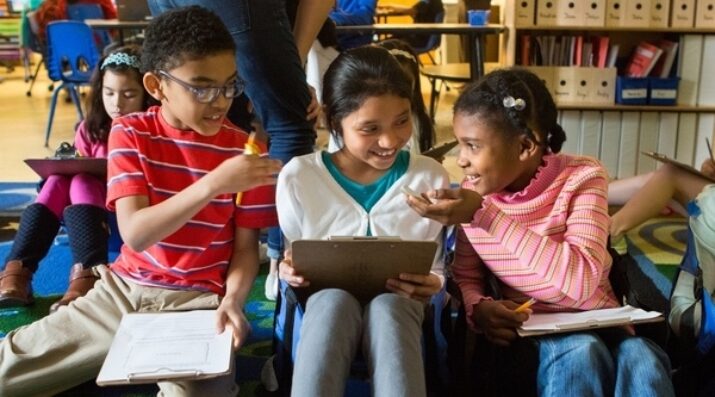New Designs for School
Connections over Consequences: Effective Strategies for Collaborative Problem-Solving with Students
Topics

We’ve all had the experience of truly purposeful, authentic learning and know how valuable it is. Educators are taking the best of what we know about learning, student support, effective instruction, and interpersonal skill-building to completely reimagine schools so that students experience that kind of purposeful learning all day, every day.
Classroom behavior management? Find out why empathetic listening and collaborative problem-solving can change outcomes and lead to better learning.
Consequences are the key to helping students learn from their mistakes! At least that’s what I used to believe. When behavior fell short of school expectations, I would enforce penalties, thinking it was in the student’s best interest. To the students, these consequences often felt more like punishment than a chance to learn and grow. Instead of improving classroom behavior, my approach seemed to make things worse. The more I tried to enforce these rules, the more ineffective the results became.
I continued that frustrating cycle until my principal suggested the book Lost at School by Ross W. Greene. In the book, Greene suggests students do well if they can. Greene provides strategies and resources for collaborating with students to co-create solutions. At that time, I strongly disagreed. It seemed to me that the kids just didn’t care. Nevertheless, I decided to put Greene’s suggestions to the test. At my wit’s end, I had nothing to lose.
The first step was to understand the student’s concerns. To my surprise, most students were eager to share their perspectives. All I had to do was listen! As students began sharing their lives with me, a solution would often present itself. More often than not, there was an unmet need or lagging skill. Though this was simple, it was not easy! I had to learn how to ask open-ended questions and even to remain silent, as the students reflectively considered their situation. As caring educators, we often compassionately offer solutions. To support students in advocating for themselves, I focused on helping them connect how their behavior impacts their outcomes. By facilitating their reflection and problem-solving processes, I encouraged them to explore and identify their own solutions.
While some students were open to communication, others faced challenges such as outbursts or withdrawal. I recognized that I required different strategies to better support my students. In my search, I discovered innovative teaching methods, including the blended learning techniques encouraged by The Modern Classrooms Project, which offers a free course for differentiated instruction and multi-modal learning within the lessons. I also discovered science-backed programs such as Crisis Prevention Institute (CPI) and Therapeutic Crisis Intervention for Schools (TCIS), that help educators create a safe, caring, and supportive environment. These resources helped me better support my students and proactively manage challenges without escalating conflicts.
This approach supported students in developing responsible habits, and reinforced the collaborative partnership between the school and families
Let me share a real example from my time as a middle school coordinator. We had a recurring issue with new middle school students forgetting to charge their devices. Our initial solution was to impose “unprepared write-ups” and require students to make up missed assignments on their own time. This approach only led to more frustration among students, families, and teachers. Grades suffered, relationships were strained, and teachers spent valuable time on write-ups. It was clear we needed a new plan.
After talking with a group of students who had received multiple write-ups, we learned that many had busy after-school schedules and simply forgot to charge their devices amid the afternoon hustle and bustle. Through empathetic listening, we were able to understand their situation better. The students themselves suggested the need to charge their devices during the school day, without facing punishment.
With this insight, we developed a support plan that included a charging dock and scheduled times for students to charge their devices during morning arrival, lunch, and recess. This approach supported students in developing responsible habits, and reinforced the collaborative partnership between the school and families, aiming to ensure a smooth transition to middle school for the students.
While my ongoing journey with empathetic listening and collaborative problem-solving has been incredibly rewarding, I recognize that every aspect of teaching offers its own unique challenges and rewards. Believing that every child wants to succeed has helped me build deeper, more meaningful connections with my students. This approach supports students in connecting their actions to their outcomes, rather than simply avoiding punishment. Collaborative problem-solving encourages self-awareness, relationship-building, and critical thinking. Through this process, I’ve grown both as a teacher and as an individual, finding greater happiness and fulfillment in my work. Additionally, I’ve developed a stronger sense of mindfulness and self-compassion. Here are some strategies I learned along the way:
1. Provide a safe, supportive, and inclusive environment.
- Include a quiet area of the classroom for students who need to self-regulate without leaving the classroom.
- Consider teaching methods such as the blended learning techniques taught by The Modern Classrooms Project and cultural and trauma-sensitive approaches to include all students.
2. Encourage self-awareness and critical thinking.
- Offer students opportunities to explore and express their emotions concerning classroom challenges.
- Help students see how their actions affect their results by connecting behavior with outcomes.
- Determine if students lack specific skills or have needs that contribute to the undesirable behavior.
Allow students to role-play and practice alternative solutions.
3. Use empathetic communication to collaborate with students and their caregivers.
- Collaborate with students and their families using active listening and open-ended questions.
- Strategize with the students and caregivers to find solutions that address everyone’s concerns, including those of the teacher. By working together, we can ensure solutions meet the student’s needs, while also aligning with the teacher’s goals and classroom dynamics.




